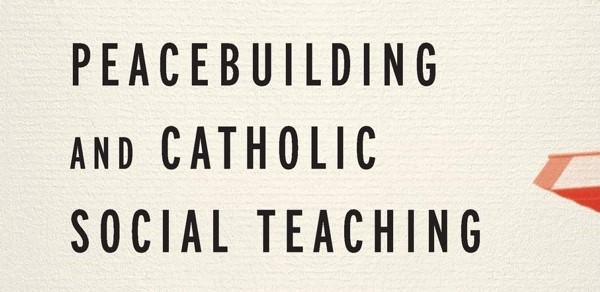Theodora Hawksley’s admirable, meticulous and creative book is divided into two parts.
The first two chapters offer a historical perspective: from ‘The Early Church to Aquinas’, then from ‘the New World to the Present’. The first chapter, especially, is brief and highly selective, but introduces two traditions, virtually paradigms, of Christian social thought deriving respectively from Augustine and Aquinas. The second part treats, successively, four foundational themes. In a final chapter she draws the threads together while deepening them further.
Two overall perspectives give coherence to the book as a whole.
First is the relationship between the goods of this present life, including peace, and the definitive goods of the reign of God, in terms of two paradigms. It would be crass to call Augustine a ‘pessimist’; but he posits a radical discontinuity between even genuine (but necessarily ambiguous) goods of this age, and the spiritual goods (humility, love, etc.) which may be experienced now but are the definitive goods of God’s reign. Logically, therefore, Augustine does not admit the possibility, in human societies marked by sin, of long-term social transformation.
For Aquinas, Creation is good precisely because it is: humans, endowed by God with intelligence, can perceive, interpret and obey the ‘natural law’. Aquinas proposes a triad: grace completes nature, the gospel completes law, charity completes justice.
Hawksley argues of Catholic Social Teaching (CST) that the Aquinas paradigm became dominant in Pope John XXIII's 1963 encyclical Pacem in terris, which stresses the potential continuity between earthly and eschatological goods. As geopolitics from the late 1960s turned more conflictual, and as global conflicts were more fully reported in all their devastation, ‘realism’ has demanded Augustinian qualifications.
The second unifying perspective emerges in the chapter on 'Pastoral Accompaniment'. Hawksley is less concerned with analysing magisterial texts addressing national and international institutions (on global issues such as nuclear disarmament) than with reading and reconstructing CST so that it embraces a theology and spirituality which can better resource communities on the ground. Most global conflicts today are not inter-state but intra-state. They are fought primarily by non-professional soldiers, without clear patterns of authority, and involve brutal but ‘non-conventional’ weapons of war: rape, kidnapping, abduction as forced soldiers. Diplomats and international institutions are experienced as remote and ineffectual. The local Church, though, often remains present long after other humanitarian organisations have abandoned their mission. The burden - and the responsibility - of peacebuilding is borne by afflicted community groups.
In such situations, faithful pastoral accompaniment is defined by a presence to suffering that reflects the faithfulness of God in even the most dire situations. Ceremonies of grieving, for instance, are both personal and transpersonal, embodying a refusal to dehumanise victims by writing off deaths as ‘collateral damage’ or ’necessities of war’. Equally challenging is the assertion that presence to victims demands discernment: to be close to those who suffer systemic violence is to risk being sucked into a frame of reference quite other than peace, into ethnic or political patterns of revenge and mimetic violence.
Solidarity is a concept more familiar in discussions of economics than of peace. Although the term was scarcely used in CST until the papacy of John Paul II, the interdependence of humans is a key assertion of the natural law tradition; if that interdependence is a fact, solidarity is the corresponding virtue, and the virtue can exact a terrible price. Bearing in mind her first perspective, Hawksley suggests that, in following that natural law tradition, much CST shows ‘remarkable confidence’ that, since humanity is ‘intrinsically social’, people and institutions can do for each other (by grace and good will) what they ought to do. That confidence may seem hollow to those who are the victims of devastating and intractable violence or injustice, and from her second perspective she identifies two deficiencies in the teaching.
The central magisterial tradition aspires to universality. It deals primarily with general principles (human dignity, the universal destination of the goods of creations, etc.). It calls on church leaders to commend these principles to international institutions and actors. At the individual level it calls for conversion. However, it gives scant attention to the crucial mid-level activity of groups and communities, working together for peace and healing. Here, Hawksley's reconstruction of CST has recourse to Scripture and indeed to the Ignatian Spiritual Exercises. She relates the El Salvador murders in 1989 of six Jesuits and two women to Ignatius’s meditations on the Incarnation and the Crucified Christ. God’s ‘movement towards the earth in love’ and Christ’s total self-giving to the divine will confront the dimension of tragedy and of total sacrifice that ultimately grounds solidarity, and which can be experienced by grassroots peacebuilders as their hopes are dashed time and again.
Hawksley next turns to the concept of social sin. However blatant social and structural injustice appears in today’s world, especially when experienced from the side of victims, structural thinking fits awkwardly within the tradition of moral theology and CST. The ‘manualist’ tradition (primarily directed to priest-confessors) treats sin as, by definition, individual, act-centred (whether by commission or omission), counter to natural law and human reason. Social context might mitigate guilt without affecting the objective status of an act. Any invocation of ‘social sin’ is suspected of compromising ’personal responsibility’.
Vatican II changed the tone of this discourse, but the decisive change emerged from meetings of the episcopal conferences of Latin America in Medellín (1968) and Puebla (1979). Pope St John Paul II acknowledged their insight but preferred to speak of ‘structures of sin’, conceiving ‘social sin’ as the accumulation - the effect - of individual sins: ‘sin by analogy’. Yet social sin is not simply a plural failure of individual consciences, but a matter of relations between groups. (It is noteworthy that this individual, act-based paradigm must equally also characterise original sin - which certainly looms large enough in the Catholic imagination - as ‘sin by analogy’.)
Hawksley's reconstruction here, drawing for instance on Rahner’s account of concupiscence, explores how shared attitudes reach beyond the conscious level into the visceral, and affect us prior to our freedom. Consider how socially constructed are subliminal attitudes to the police, to immigrants, to the racial or religious other. False consciousness may be passed down the generations, resulting in, say, uncontrollable fear. The individual and the social are mutually constitutive.
The book’s final theme is the timely one of reconciliation. Hawksley describes how the Church’s discourse has been closely bound to the sacrament of confession, linked to the work of priests rather than to the task of the Church as a whole. The Church does not primarily dispense the reconciling mercy of God: firstly, Christians receive that mercy, and their mission is to accept that divine initiative and ‘not hinder’ its flow beyond the Church. She cites moving cases from Rwanda and Guatemala. Further, since many who seek peace will never live to see the fruits of their struggle, the book, here as elsewhere, bridges the temporal and eschatological dimensions of Christ’s gift of peace.
A final chapter concerns the desire for peace. For Augustine, there is no one who does not desire peace, though the peace they seek may be corrupt, not graced. ‘Everyone has sinned’: we humans are divided against ourselves. However, disorder, though predatory and sometimes viciously destructive, is contingent on some prior order. For Aquinas, that prior order is intrinsically good. In Pacem in terris, for example, the desire for peace is represented as a rational attraction to this good, growing towards God and continuous with God’s peace.
Frank Turner SJ is a fellow in political theology at Campion Hall, University of Oxford.






